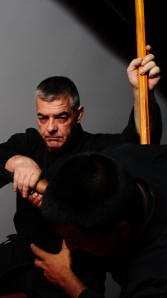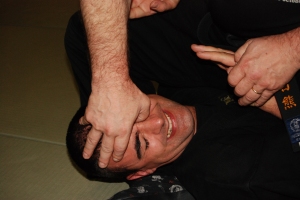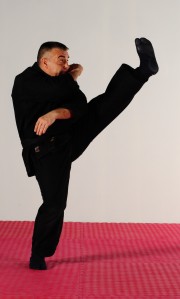From Shiro Kuma's Weblog by kumafr
Do you really understand what the Bujinkan is?
When I give seminars, I am always astonished to discover the misconceptions carried out by so many teachers and students all over the world. As I said once during a seminar: “no one is forcing you to claim to be “Bujinkan”, if you want to do your own stuff then do it but do not call it Bujinkan!”.
So it was a real pleasure last week-end to meet Manolo Serrano’s group in Belgium and spend some time with him and the Mitrou brothers from Greece. All of them being 14th dan, it was good to share our common vision of the art. On the way back, I thought it would be appropriate in this blog to refresh our memories about what is the Bujinkan really is.
When Hatsumi sensei began to spread his vision on budô and to share it all over the world, there was no plan, no step by step process going on. Hatsumi sensei was only sharing his knowledge to everyone willing to listen. Then in 1983 he published, in Japanese, his first “ten chi jin ryaku no maki” detailing the basics and fundamentals of our art. A revised version of it translated into English reached us in Europe in 1987. Ten years later Hatsumi sensei decided to move on and established a theme and a concept to work with for each year.
In 1993, I was lucky to be already jûdan in the Bujinkan so I had enough basics to follow sensei’s evolution in his teachings. As many Bujinkan practitioners of today were not students at that time, I want to list here once again those themes that created the art we know now.
After the ten chi jin, we learnt distancing and angling for 5 years:
- Bô jutsu – 6 feet staff (1993),
- Yari jutsu - spear (1994),
- Naginata jutsu - halberd (1995),
- Biken jutsu – sword (1996),
- Jo jutsu - 3 feet staff (1997).
During the Valencia Taikai (1995) and again in Sanmyaku (the Bujinkan newsletter of that time) Hatsumi sensei said that “bô, yari, naginata are the sanshin no kata of long weapons”.
Then we entered the world of budô taijutsu and studied not the schools (as it is often believed) but the 5 pilars of body movement, through five of the 9 schools that was:
- Taihen jutsu – shinden fudô ryû (1998),
- Daken taijutsu - kukishinden ryû (1999),
- Koppô Jutsu - kotô ryû (2000),
- Kosshi Jutsu – gyokko ryû (2001),
- Jûtaijutsu – takagi yôshin ryû (2002).
This second cycle of 5 years that can be related in some way to the gogyô allowed us to understand (through training within specific schools) the various way of meeting the opponent and adapting our ways of fighting to the situation.
The third cycle has been even more complex as we entered the world or dimension of juppô sesshô (negociating in ten directions). That was also a 5 years long cycle. Juppô Sesshô is the highest mechanical and technical level in any martial system (ryûha) in Japan and gives the ability to adapt a specific type of fighting to any situation encountered. As for the second cycle (the 5 pilars of budô taijutsu), the important point here had nothing to do with either the weapon we used or the school studied. The juppô sesshô cycle was the following:
- Sanjigen no sekai – kunai & shotô (2003),
- Yûgen no sekai – kukishin sword (2004),
- Kasumi no hô – gyokko bô (2005),
- Roppô kuji no biken – sword and yoroi (2006),
- Kuki taisho - sword and yoroi (2007).
The juppô sesshô has discouraged a lot of practitioner and even today many of the shidôshi really have no clue of what has been studied during these 5 years. Many teachers do not understand the depth of what we have been receiving. How many of them know that the techniques of the kukishin ryû bô jutsu were used to teach the feeling of kasumi from the gyokko ryû? Also the move from “happô” to “juppô“ has to be seen as some kind of a quantum leap in the world of Bujinkan physics.
This juppô sesshô cycle ended the series that we can now see as a kind of ten chi jin. We all know that the ten ryaku deals with footwork (angle, distance); the chi ryaku with the body mechanics (budô taijutsu); and the jin ryaku with a mix of everything (moving from body to spirit).
This 3 steps progression (sanpô) of 5 years (gohô) therefore can, or should, be considered as the true kihon happô of the Bujinkan (3×5=8!).
Then it was time to begin the study of shiki – consciousness- the 6th element that sensei introduced to the community back in 2005. So we studied things based more on “philosophical” concepts than schools or mechanical movements. That was:
- Menkyo kaiden - destroy the thinking process (2008),
- Sainô kon ki or sainô tamashii utsuwa – ability, spirit, container(2009)
- Rokkon shôjô – happiness is the essence of life (2010).
If Hatsumi sensei follows the 5 year cycle that he, apparently followed until now, we can expect the end of this for 2012. But this is only a guess.
I hope that this little review of the various themes will be helpful to you and that now you can answer the initial question:
Do you understand the Bujinkan?
Be happy!
 … Read More
… Read More


 …
… 
 …
…  …
… 
 …
…